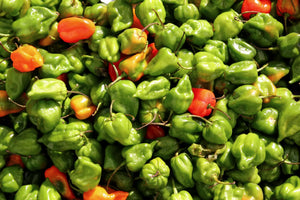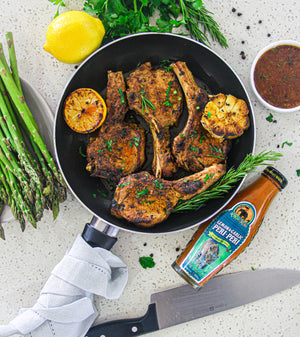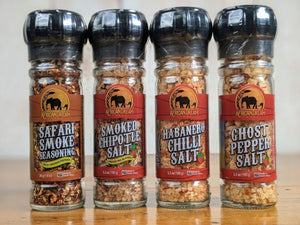Exploring the Habanero Pepper
Apr 13, 2023
Although habanero pepper lost its ‘World’s Hottest Pepper’ crown in 1999, that doesn’t mean it’s not very hot and spicy. At 350,000 and more Scoville heat units (SHUs), it takes a proud spot in the peppers’ hall of fame. So if you’re looking for a grand upgrade from your usual spicy meals, the habanero pepper is a pretty courageous choice. Before diving into the world of habanero peppers, it’s essential to familiarize yourself with their characteristics. This comprehensive guide will provide you with all the information you need to master the art of incorporating habanero peppers into your dishes. Continue reading to unveil their tantalizing secrets!
How Hot Is a Habanero Pepper?
We’ve already mentioned that habanero pepper can reach 350,000 and more SHUs, but how hot is that?

We’ll give you an easy comparison. If you’re a spicy food enthusiast, then you’ve indeed eaten jalapeno pepper before. Well, as shocking as it is, a jalapeno pepper only ranges from 2,000-8,000 SHUs, so you can stop bragging to your friends that you can eat an entire pepper in one bite.
Accordingly, you can figure out how hot a habanero pepper is. It takes up a noticeable space in the extra-hot zone of the SHU scale. However, and this may surprise you, it is still not as spicy as heavy hitters, such as the ghost pepper, like ghost peppers, for example. Those can easily reach one million SHUs. So, you can eat them if you’re up for a challenge.
More so, the habanero pepper is humbled when compared with the hottest peppers in the world right now—for instance, Carolina Reaper and Trinidad Moruga Scorpion, which can reach up to two million SHUs. However, since those are less common in grocery stores, habanero pepper still sits on the throne of the hottest pepper that you can buy on the market.
What Does a Habanero Pepper Taste Like?
We must have teased your taste buds by now. So if you’ve never tasted a habanero pepper before, let us give you an idea about what to expect. Surprisingly, habanero pepper has a fruity undertone that adds value to many dishes around the world. That’s why it’s a favorite among chefs.
In addition to the citrusy sweetness, habanero pepper also has a smoky taste that makes it even more unique. Those qualities made habanero pepper a star of fruit-based dishes, especially mangos and pineapples.
If you’re courageous enough to taste a habanero pepper, you’ll be shocked at first with an intense explosion of flavors hitting your mouth, followed by a severe heatwave. However, cooked peppers lose a bit of their flavor when subjected to heat, so they don’t feel the same.
After getting over the initial shock, you’ll enjoy the fruity undertone along with a dash of smokiness. If you don’t want your first experience to be aggressive, you can eat it cooked instead of raw. People often remove the pepper’s seeds and the white inner membranes before cooking with it, and since this is where capsaicin is most concentrated, cooked peppers are much less intense than raw ones.
What Are Habanero Peppers Good For?
Apart from the delicious taste that habanero peppers provide, they also have a few health benefits that most people don’t know. Studies even show that people who eat spicy meals frequently have a lower risk of developing diabetes and cancer.
First of all, since they’re full of capsaicin, they can lower the bad cholesterol in your blood without affecting the good cholesterol. And the best news is that this fact isn’t limited to a specific dose. So you don’t have to eat an entire plate of habaneros to enjoy those benefits.
Second, capsaicin can stimulate increased production of insulin-like growth factor-1, which is a hormone that can cause a slight reduction in blood pressure.
Not only those, but habanero peppers can also increase your metabolism, therefore make you lose weight faster than usual. They do that by increasing thermogenesis throughout your body, which is the metabolic process by which we burn calories and gain heat.
Like most spicy food, habanero pepper can give you a mood boost after eating it. This is mainly because our brains release endorphins, which are happy hormones, as a response to the burning sensation that aggressively attacks our mouths. This causes a euphoric feeling that leads many people to become addicted to spicy food.
Last but definitely not least, eating habanero pepper can reduce your chance of getting cancer. To elaborate, habanero pepper contains vitamin A, vitamin C, and capsaicin. Those can play a huge role in preventing the emergence of cancer cells in your body, especially in the prostate.
With that being said, habanero pepper may not be for the faint of heart. But it sure is delicious, and you wouldn’t want to miss out on its taste. So if you plan on incorporating it in your meals, just keep the portions tiny, and enjoy!
Types of Habanero Pepper
Since humans have been inspired by natural evolution since forever, there have been many attempts to modify habanero pepper in terms of taste, shape, and color. So, due to many trials of natural selection and crossbreeding through ages, many types of habaneros rose to fame. Here’s a roundup of some exciting varieties of habanero peppers.
Chocolate Habanero

While you may associate its name with sweetness, this isn’t the case. Chocolate habanero gets its name from its unique brown color. If you ever decide to plant them, chocolate habaneros can add an elegant touch to your garden. However, don’t let the dark brown color trick you into thinking it isn’t as spicy as the other habanero types.
As well as the explosive spiciness, chocolate habanero also preserves the characteristic fruity flavor of habanero pepper. However, it’s spicier than most habanero types at nearly 570,000 SHUs. Thus, it adds value to many recipes, for instance, pepper powders and hot sauces.
Habanada

This habanero pepper is for people who don’t want to miss out on the experience of eating habaneros, but they’re a bit scared of the spicy taste. It provides the same exceptionally delicious taste, but without the original habanero’s spiciness.
If your first habanero to try is the Habanada, then you’ll enjoy it. However, if you’ve tasted the original peppers before, you may find it a bit weird at first because it doesn’t hold the same amount of flavor. Habanada is perfect for cooking mild hot sauces.
Mustard Habanero

Mustard habaneros carry a characteristic orange color that ought to warn you about their spiciness. If you ever decide to grow them, you’ll get to enjoy a lively color in your garden and a delicious flavor in your meals.
After their name, mustard habaneros are a superb addition to hot mustards.
White Giant Habanero

While it isn’t as large as the name hints, the White Giant habanero is definitely unique.
Compared to other white habaneros, it’s only slightly larger. In addition, it preserves the same fierce heat and mild smoky flavor that gave habanero its popularity in the peppers world.
Scotch Bonnet
While many people think that Scotch bonnets are a type of habaneros, they’re only a close relative. This type of pepper carries the same spiciness you would expect from the hot pepper; however, its fruity undertone is much more prominent than habaneros.
The reason they’re named this way is that they slightly look like a type of Scottish hat. Scotch Bonnets gained popularity around the Caribbean, and they have an essential role in many Jamaican plates.
Big Sun Habanero
NuMex Suave

Developed at New Mexico State University, the NuMex Suave is a mild habanero variety that has a lower heat level compared to traditional habaneros. With a Scoville rating of just 800 to 10,000 SHUs, this pepper retains the fruity flavor of habaneros while being more accessible to those sensitive to heat.
Red Savina
Although all habanero peppers are pretty spicy, they’re no competition for the ever-vicious Red Savina. This champion ranks a shocking 500,000 SHUs on the hotness scale. As a result of many years of breeding to get more capsaicin out of it, the Red Savina doesn’t disappoint when it comes to intense flavors.
Habanero Colors: Which Color Habanero Pepper Is Hottest?

Habanero peppers come in a variety of weird and wonderful colors that make you sweat just looking at them! And since there are many varieties of our beloved pepper, it’s essential that you know how to differentiate it according to color. The colors available include white, green, yellow, red, orange, pink, purple, brown, and more.
To start with, green and white habanero peppers are more on the mild side. Although still pretty spicy, they won’t burn your mouth as much as the other colors. They’re also the richest in flavor as they preserve more sweetness than the others. In addition, although yellow habanero Scoville units can reach 350,000, it still isn’t the spiciest habanero pepper.
Given their fury colors, red and orange peppers undoubtedly take the first position as the hottest habanero peppers. Unfortunately, while they’re still delicious, many people shy away from adding them to meals because of their overpowering effect.
As for pink and purple habaneros, they’re a bit rarer than other types, so you might not have heard about them before. However, it’s worth mentioning that they aren’t as intense as other types of habaneros, especially the chocolate habaneros ones.
As an ultimate answer to the question, Red Savina is the hottest habanero pepper ever to exist. Make sure not to put it in your meals unless you’re up to the challenge.
Cooking With Habanero Pepper

Habanero peppers aren’t the type of pepper that you can just put on any meal. They only pair well with a few other foods because of their unique undertones. As a result, you’ll need our help if you want to include habaneros in your dishes! Luckily, we have some ideas for you.
On the other hand, you can get creative with your cooking and try a dish like a habanero hummus. It’ll be explosively spicy, to say the least, but it wouldn’t harm to give it a try.
Moreover, as we’ve said before, habanero pepper pairs well with fruits; accordingly, you can incorporate it into sauces and syrups. For a fruity and earthy flavor, you can whip up a carrot habanero sauce.
Finally, habanero becomes exceptionally delicious when fermented. It gives it a unique tangy taste that appeals to many people. And you can look for a ready-made fermented sauce, like Habanasco, for example.
Tips for Handling Habanero Peppers
Suppose you want to add a dash of intense spicy flavor to your food, then there are a few points you should take care of.

Always Wear Gloves
For starters, you should never handle peppers with bare hands, and this isn’t limited to habanero peppers. Any peppers that take a high ranking on the Scoville scale also fall under that category. It’s always the wise option to wear gloves.
Cutting those spicy vegetables with bare hands can lead to an annoying burning sensation on your skin. Not to mention, if you forget what you’re dealing with and innocently rub your eyes, the results will be catastrophic.
Keep Your Portions Tiny
When dealing with pepper as hot as habanero pepper, it’s always the best option to use a small amount. Habanero’s flavor is intense enough; as a result, you don’t need to put a generous amount in your food. Instead, to ensure you don’t accidentally make your meal too spicy to eat, taste it many times through the cooking process.
Also, you should know that the spiciest parts of any pepper are always the veins and the seeds. Accordingly, you should remove them before throwing habanero into your dish.
Peel off the Skin
Although habanero’s skin is relatively thin, it still can be pretty challenging to chew in your mouth. Consequently, it’d be best if you remove it before cooking. To do so, you can heat your habaneros over a grill for a few minutes or just throw them in the oven. Afterward, it’ll be much easier for you to remove the skins as they’ll loosen a bit. Don’t forget your gloves, though!
Adverse Effects of Eating Habanero Pepper
While there aren’t many adverse health effects associated with hot peppers, we’ll still give you an idea about them. The real culprit when it comes to spicy food is capsaicin. Capsaicin is a compound found in all hot peppers, and it can trigger heat receptors on your tongue and give your brain the wrong idea that your mouth is burning, literally.
With that being said, capsaicin isn’t dangerous in any way. Its effect is merely a mastermind trick that it plays on our minds. But we can’t say the same for people who are suffering from digestive issues or ulcers.
Those can be made worse with a meal full of capsaicin. As a result, if you’re one of them, you should consult your doctor before taking a lionhearted step like eating habanero peppers.
Can Habanero Pepper Burn Your Tongue?
Due to the excessive heat that results from eating habanero pepper, people started worrying that it might be burning their tongues. However, we’re here to prove them wrong.
First of all, capsaicin, which is responsible for the spicy taste, only stimulates the heat receptors on your tongue. It doesn’t adversely affect your taste receptors at all. Accordingly, no matter how much agony your tongue is in, it isn’t in any way burning. Instead, your mind just thinks it is.
As a result, you can indulge in spicy food as much as you want. But make sure not to go too far if you suffer from digestive issues.
Growing Habanero Pepper
Luckily, growing habanero pepper isn’t too challenging. You can easily do it if you have enough patience and the right equipment. The most crucial point to take care of is keeping it out of the sun. It may lead your peppers to dry out and crack. It’d also help if you fertilize them efficiently after they reach six weeks.

In addition, you should keep an eye out for insects. They might harm your plant, but you can quickly get rid of them using water sprays. However, don’t spray water all day long because overdoing it can cause fungal diseases.
Habanero Pepper: A Brief History
South America isn’t just famous for coffee and football; it’s also the place where habanero pepper originated.
Although many people mistakenly think that habanero is Mexican, it definitely isn’t. Some people believe it originated in Peru, while others swear it’s a Cuban plant. However, regardless of the past, the Yucatan Peninsula remains the biggest producer of those peppers to date.
In terms of being ancient, habanero pepper has been on earth for quite a while. Interestingly enough, archaeological scientists have dug domesticated habaneros that are older than 8,500 years old. Can you believe that it’s centuries older than South America?
Over time, farmers mixed types of peppers together to get the preferred color, taste, and appearance. As a result of those trials, many habanero pepper varieties rose to fame, as we’ve mentioned previously.
Since we’ve made it clear that habanero pepper belongs in South America, you must be wondering how it became famous in Africa. Interestingly, habaneros spread to the rest of the world through Spanish, British, and Portuguese colonists. Their appearance in different areas of the world has been traced back to them.
Frequently Asked Questions
Can I Eat a Habanero Pepper?
Well, it depends on your ability to withstand spicy food. And note that we aren’t talking about the expected level of spiciness that you can find in fast-food restaurants. Instead, we’re talking about an intense, hot experience, which is what you’re here for. After all, habaneros are mouth-watering, so it wouldn’t hurt to give them a try!
What Is Hotter, Habanero or Jalapeno?
According to the Scoville scale, they’re in no way comparable. For example, Habanero pepper ranks an astonishing 350,000, while the innocent jalapenos never go further than 8,000 SHUs.
Are Habanero Peppers Hotter Than Serrano?
Yes, habanero peppers are much hotter than serrano peppers. Serrano peppers have a Scoville value that ranges from just 5,000 to 15,000 SHUs, which is incomparable with habanero’s score.
Can a Habanero Pepper Kill You?
Unless it’s furiously shooting out of a gun’s barrel, no, a habanero pepper definitely can’t kill you. You’ll just suffer from a burning sensation that’s associated with spicy food. However, this goes for small amounts of the vicious pepper. If you eat a large number of habaneros, you may suffer from stomach issues. Nevertheless, they still won’t kill you.
Where Does Habanero Pepper Get Its Name?
Habanero pepper is named after La Habana, a Cuban city that’s assumed to be the origin of habaneros. La Habana is commonly called Havana in English.
Are Habanero Peppers Expensive?
Compared to other types of pepper, no, habanero pepper is definitely not expensive. It might be a bit more costly than your usual vegetables, but it won’t put a dent in your wallet. Interestingly enough, bell peppers can be more expensive than habaneros.
To Wrap Up
Among the many blessings that South America gave us, habanero pepper is pretty much one of a kind. In addition to its incredibly spicy taste, it also has a fruity flavor that earned it its worldwide fame. While its spiciness is not to kid with, you can incorporate it in meals in creative ways that won’t overly burn your mouth. For instance, you can use it in sauces or salts.
Now that you know enough about habanero peppers,you can experiment with adding these to your everyday cooking for an extra punch of flavor!




